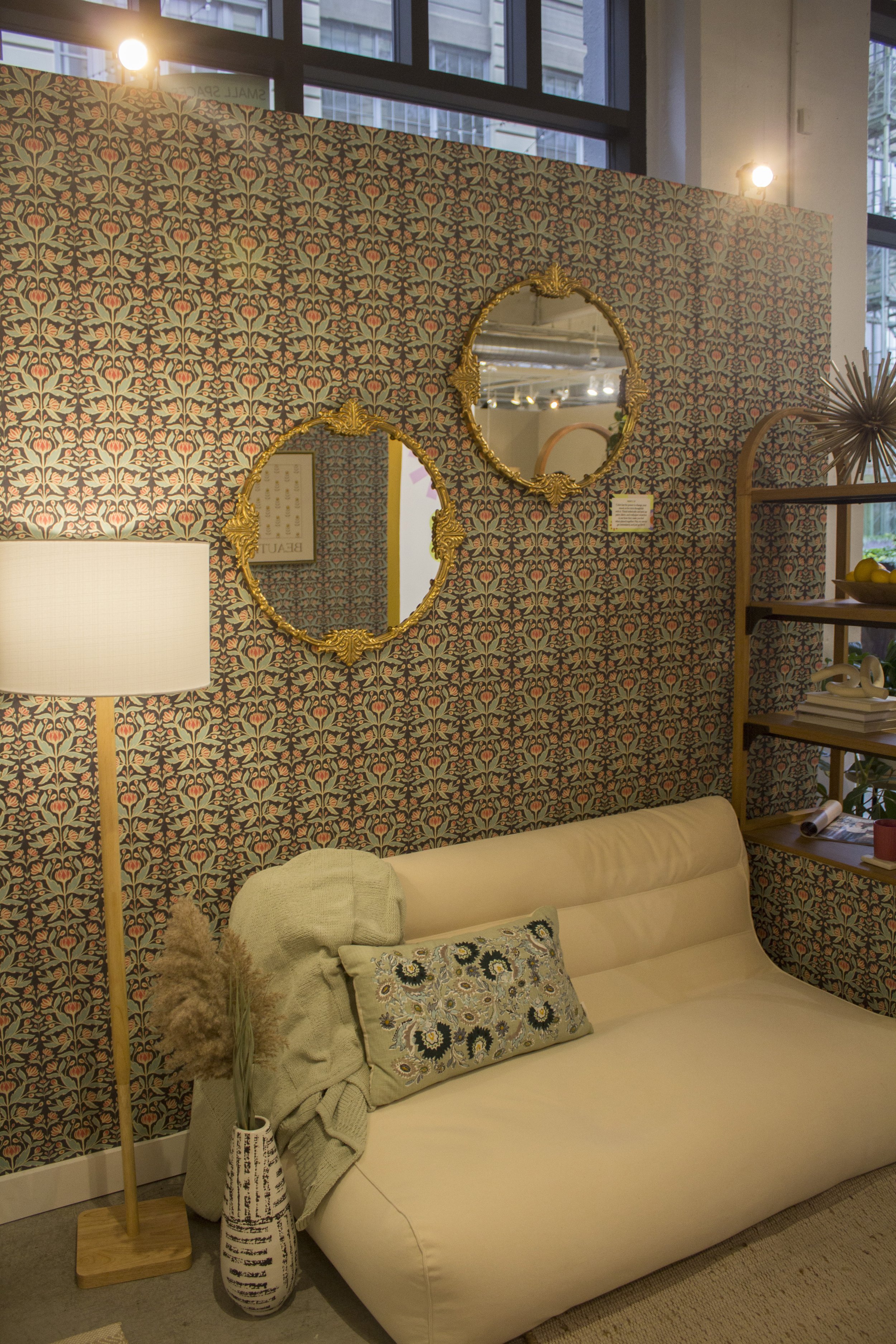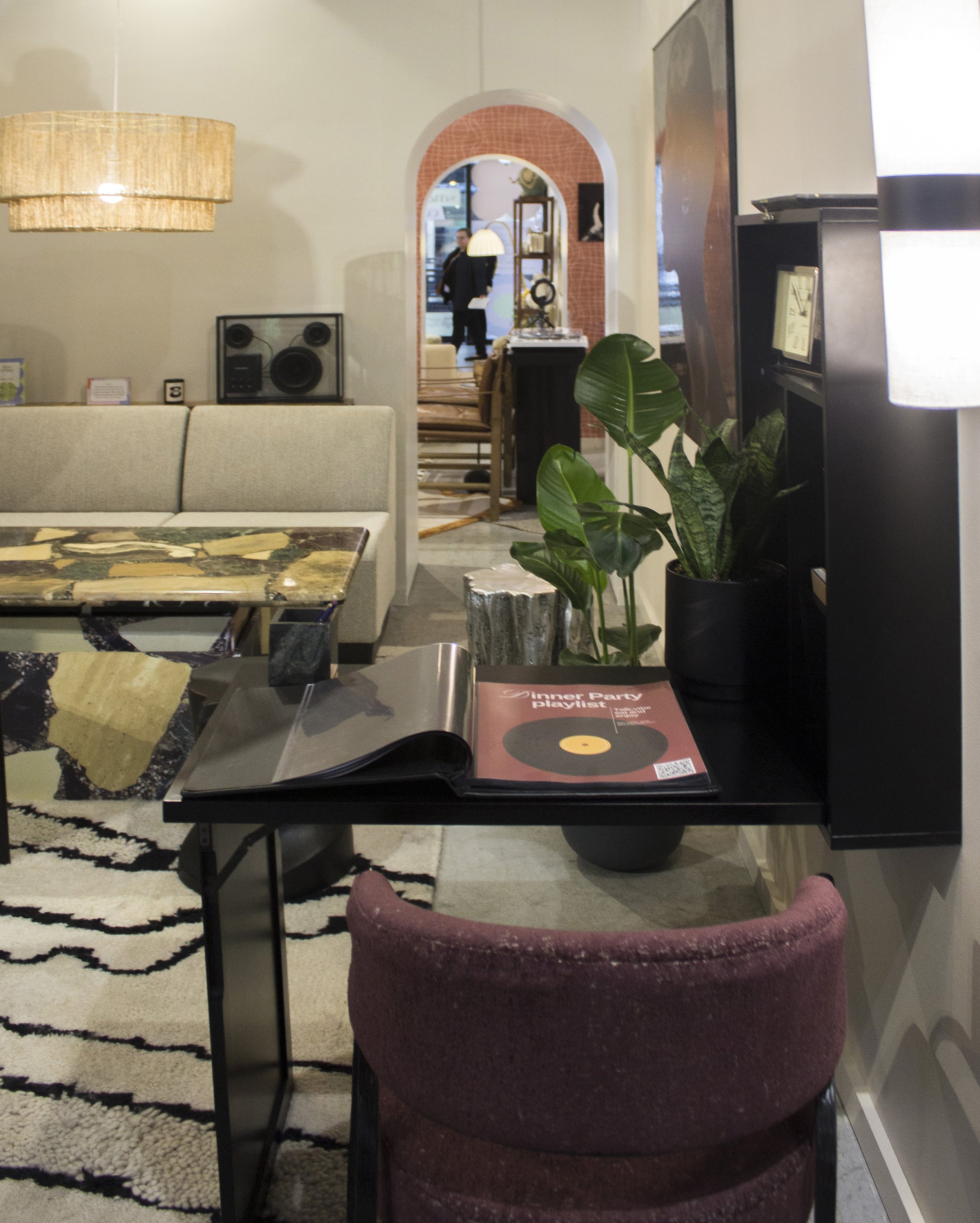Apartment Therapy’s Small/Cool NYC Pop-Up: Which Small Space Design is Ideal for Your Personality Type?
Last weekend, I visited Apartment Therapy’s Small/Cool NYC shoppable pop-up in Brooklyn. I love getting inspiration from show houses and capturing memorable pics (all photos by me). It’s always fun to see what designers are up to, and how they’re using furnishings in new and unexpected ways. The Apartment Therapy show house is especially interesting because it challenges designers to be creative with small, cramped NYC spaces. Each room is given a title that reflects the look and feel of the room, and aptly captures the unique qualities each designer brings to the space. As I processed the overall feel of the rooms and the details in it, I wondered what personality types would be ideal for them. Or, what personality types would experience the rooms as the designers intended.
According to design psychology, our response to spaces is partly attributable to our past experience with place; and a space may trigger traumatic or negative experiences, or evoke high positive associations with past places, sometimes below our level of awareness. What’s more, our personality, including enduring thoughts, feelings, and behaviors that were developed within the context of these past places, also impact our experience of place. And while personality is complex, Dr. Sally Augustin in her book, Designology: How to Find Your PlaceType & Align Your Life with Design, simplifies it for us, offering place types based upon a few basic components of personality.
Essentially, Dr. Augustin highlights three components of personality, including introvert/extrovert, conscientiousness, and openness to experience. Keep in mind that both extroverts and introverts may be great with people and have the ability to move a crowd. The only difference is that people who are extroverted tend to get their energy by being around others, and those who are introverted tend to get their energy or recharge by being alone. Conscientious people are engaged, orderly, and very specific whereas less conscientious people are more laid back. And those open to experience tend to be more daring whereas those less open to experience tend to stick with tradition or what they know.
Of course, many people don’t fall neatly into any one category; and we may have more or less of any one personality component. But Dr. Augustin’s scale is a quick way to begin thinking about where you lean; and better determine what design styles are most compatible with a working understanding of your personality. For example, extroverted people tend to be more inclined to favor open spaces with high energy, whereas introverted people tend to favor calming spaces that are segmented and allow for private time. Conscientious people are inclined to keep things orderly without much effort, and those who are laid back may need more organizational tools to keep things in order. Those who are open to experience are likely to try something new and unusual than those who are less open to experience.
So using Dr. Augustin’s personality components, I decided to link personality types to some of my favorite rooms in the show house. While Dr. Augustin uses fancy names to identify the varied dimensions of personality, I won’t identify those names here for the sake of simplicity. Instead, I will just refer to the personality dimensions themselves.
Drew Barrymore’s Sunny Style Studio: Extrovert, Conscientious, and Less Open to Experience
Drew Barrymore’s “Sunny Style” studio is said to feel like a “big hug”. It’s meant to be a “delightful”, “cheery”, and “functional” space. And with pastels, rounded comfy seating, wood surfaces, and busy wallpaper, I’d say it is perfect for someone who is extroverted, conscientious, and less open to experience.
Here’s why: according to the theory of color psychology popularized by Angela Wright, we are most responsive to seasonal-linked color groupings that match our personality patterns. Specifically, a spring-linked palette is characterized by bright and warm colors, containing no black. It’s associated with being playful, light in mood, and of course, extroversion. And let’s not overlook the William Morris-esque wallpaper. Research shows that curvilinear patterns like this are associated with friendliness and comfort, all very fitting for the gregarious person living in this “Sunny Style” space.
Next, conscientious people are inclined to be organized and orderly with a penchant for details. So all of the open shelving and functional tools available in this room may be a dream for the more conscientious amongst us looking to show off their organizational skills. And while being less open to experience might seem like a negative, it isn’t. Keep in mind that personality categorizations are designed to help us gain self-understanding, not a judgment. So if you are less open to experience, it simply means you’re inclined to stick with the tried and true, leaning towards more traditional styling. And what’s more traditional than patterned floral wallpaper, wood paneled walls, and natural wood surfaces?
Hollie Velten-Lattrell’s Historic Nowstalgic Salon: Introvert, Laid-Back, Open To Experience
Hollie Velten-Lattrell’s salon appealed to my affinity for modern, English style. With it’s select vintage pieces and bespoke furnishings tied together with modern sensibilities, I’d say it best suited for one who is introverted, laid back, and open to experience.
Here’s why: as mentioned above, introverts enjoy their alone time, and may want to step aside from the action a bit. Velten-Lattrell’s space has several different seating areas, also referred to as nested layers, that allow people different options within a larger space. So if someone prefers to be alone rather than talk with others, they can. Another thing to point out is the fairly neutral, faded color scheme with a few scattered patterns. Overall, it gives the feeling of calm, most suitable for those who are inclined to prefer relaxed rather than highly stimulating spaces.
Those who are less conscientious tend to be carefree in their approach to design. And if an arrangement works, they may not exert the effort to change it. Velten-Latrell’s salon feels very easy-breezy, including its functionality as the floral print skirted sette doubles as a lounger. Personally, I’d love to lay out on the settee in front of that bespoke chandelier. The low-hanging skirted fixture creates a sense of intimacy and unpretentiousness characteristic of a more laid back vibe. And the coffee table doubles as both a place to hold drinks and play games, creating a lived-in, laissez-faire kind of feel.
I’d add that the introverted, laid-back person who is more open to experience would particularly enjoy the eclectic furnishings. A floral skirted sofa together with a glitzy mirrored side table; and a vintage modern chair (with to die for chrome legs and circle- shaped feet) next to an antique-looking tapestry is a treat for the daring.
Kim White’s House of Hacks Living Space: Introvert, Conscientious, Open to Experience
Kim White’s cool, chic modern living space is loaded with multipurpose, functional, and well-appointed furnishings. It’s just right for the jet-setter who needs to come home and regroup before their next trip abroad. With a restrained, yet dramatic color palate; a marble coffee table that doubles as a dining table; and earthy, old-world furnishings sprinkled throughout, this space would be ideal for someone who was introverted, conscientious, and open to experience.
Here’s my take: chic introverts would be really into this minimal color palette. Introverts also respond well to curated spaces enhanced with varied textures, secents, and sounds as they are particularly sensitive to sensory stimuli.
As mentioned above, the creative functionality of the space would delight those high in conscientiousness. More than the marble coffee table turned dining table, the neo-traditional storage cabinet also houses a bar, and the wall-mounted desk folds up into a cabinet. These hidden functional items gives the conscientious their much desired efficiency and organization for a clutter-free look.
And appealing to the daring, the mix of earthy and old-world furnishing such as the tree stump stool and the weathered pot, along with classical styles like the bust stool, and modern, streamlined pieces creates a world traveled feel that suggests openness to different experiences.
Maitri Mody’s Creative Cabinetry: Extrovert, Conscientious, Open to Experience
Maitri Mody’s charming and energizing Scandinavia-inspired space is sure to brighten up moody mornings. The cabinets are said to be “vehicles for self-expression” and when your home feels like you, it goes a long way towards fulfilling your psychological needs. I’d say this space best suits someone who is extroverted, conscientious, and open to experience.
Here’s why: extroverts tend to be most responsive to highly stimulating spaces; and this is achieved with a number of details such as the bright colored square tiles, different color cabinets, and quirky knobs.
The kitchen space also includes colorful options for storage; and I think it’s safe to say those high in conscientiousness would be very into it. While those less open to experience are not necessarily risk averse, they may not be as excited by painting their cabinets two different colors in the way those more open to experience might be. For the more daring, it’s an opportunity to go against the grain and try something unusual.
So what do you think–does your personality style fit any of these rooms? Or, are you drawn to any of the rooms in spite of what we might think given your personality? Maybe you saw other rooms in the show house you’d prefer. If so, I’d love to hear about them and why…Share with us in the comments.














